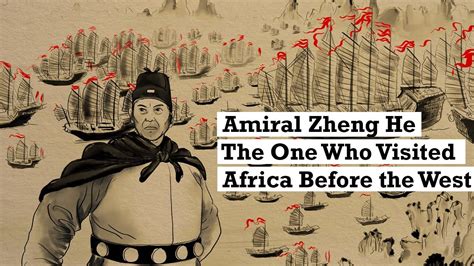Early Life and Voyages
Zheng He, also known as Cheng Ho, was an esteemed Chinese mariner, explorer, and diplomat who lived during the Ming dynasty. Born into a Muslim family in 1371, Zheng He embarked on a series of groundbreaking maritime expeditions from 1405 to 1433, spanning over 30,000 nautical miles.

Expeditions and Discoveries
Sponsored by the Yongle Emperor, Zheng He’s expeditions involved a colossal fleet of over 200 ships, manned by 28,000 sailors. His voyages took him as far as the Red Sea, the east coast of Africa, and Southeast Asia, establishing diplomatic ties with over 30 countries and accumulating immense knowledge about the world.
Domestic and International Impact
Zheng He’s expeditions significantly bolstered China’s maritime power and prestige. The wealth and tribute he brought back from his voyages enriched the imperial treasury, while the exchange of knowledge and ideas fostered cultural and technological advancement. Moreover, Zheng He’s diplomatic efforts promoted peace and stability in the Asia-Pacific region.
Legacy and Recognition
Zheng He’s maritime endeavors left an enduring legacy in world history. His expeditions paved the way for future exploration, influenced global trade patterns, and established enduring cultural exchanges between China and other nations. Today, Zheng He is recognized as one of the greatest explorers of all time, and his name and achievements continue to inspire awe and admiration.
Timeline of Zheng He’s Expeditions
| Expedition | Dates | Destinations |
|---|---|---|
| First | 1405-1407 | Southeast Asia, Sri Lanka, India |
| Second | 1407-1409 | Java, Sumatra, Malacca, India |
| Third | 1409-1411 | Sri Lanka, India, Malacca, Java, Sumatra |
| Fourth | 1413-1415 | Malacca, Java, Sumatra, India, Sri Lanka |
| Fifth | 1416-1419 | Hormuz, Aden, Mecca, Jeddah |
| Sixth | 1421-1424 | Hormuz, Aden, Mogadishu, Malindi |
| Seventh | 1430-1433 | Hormuz, Calicut, Ceylon, Southeast Asia |
Significance of Zheng He’s Expeditions
-
Expansion of Maritime Knowledge: Zheng He’s expeditions extended China’s knowledge of the world beyond its traditional boundaries, charting new coastlines, collecting information about foreign cultures, and documenting weather patterns and ocean currents.
-
Diplomatic Successes: Zheng He’s diplomatic skills were instrumental in establishing alliances, securing trade agreements, and promoting peace and stability in the Indian Ocean region. He established tributary relationships with numerous kingdoms, including those in Southeast Asia, Africa, and Arabia.
-
Technological Advancements: Zheng He’s fleet incorporated innovative shipbuilding techniques, navigational instruments, and weaponry, which significantly advanced China’s maritime capabilities and facilitated long-distance voyages.
-
Cultural Exchange: Zheng He’s expeditions facilitated the exchange of knowledge, ideas, and goods between China and other nations. Missionaries, artisans, and merchants accompanied the fleet, sharing knowledge of Chinese medicine, agriculture, music, and ceramics.
Common Mistakes to Avoid
-
Underestimating the Scale of Zheng He’s Expeditions: Zheng He’s fleet comprised hundreds of ships and thousands of sailors, making his expeditions among the largest and most extensive of their time.
-
Ignoring the Diplomatic Significance: Zheng He’s voyages were not primarily military endeavors but rather diplomatic missions aimed at establishing trade relations, securing tribute payments, and promoting peace.
-
Overlooking the Scientific Impact: Zheng He’s expeditions collected valuable scientific data, documenting weather patterns, ocean currents, and the geography of distant lands.
Tips and Tricks for Understanding Zheng He
-
Examine the Evidence: Study historical sources such as the Yongle Encyclopedia and the Nautical Map of the Ming Dynasty to gain insights into Zheng He’s expeditions.
-
Consider the Context: Explore the political, economic, and cultural factors that influenced Zheng He’s voyages and the Ming dynasty as a whole.
-
Draw Connections: Identify the similarities and differences between Zheng He’s expeditions and those of other famous explorers, such as Christopher Columbus and Vasco da Gama.
Table of Zheng He’s Fleet
| Ship Type | Number | Size |
|---|---|---|
| Treasure Ships | 63 | 40-80 meters in length |
| Horse Ships | 60 | 50-60 meters in length |
| Transport Ships | 40 | 30-40 meters in length |
| Supply Ships | 20 | 20-30 meters in length |
| Other Vessels | 20 | 10-20 meters in length |
Table of Zheng He’s Voyages
| Expedition | Destination | Year |
|---|---|---|
| First Voyage | Southeast Asia | 1405-1407 |
| Second Voyage | Calicut, India | 1407-1409 |
| Third Voyage | Calicut, India | 1409-1411 |
| Fourth Voyage | Calicut, India | 1413-1415 |
| Fifth Voyage | Calicut, India | 1416-1419 |
| Sixth Voyage | Calicut, India | 1421-1424 |
| Seventh Voyage | Calicut, India | 1430-1433 |
Table of Zheng He’s Diplomatic Achievements
| Kingdom | Relation | Year |
|---|---|---|
| Malacca | Tributary | 1405 |
| Java | Tributary | 1405 |
| Sumatra | Tributary | 1407 |
| Aden | Tributary | 1417 |
| Hormuz | Tributary | 1419 |
| Mogadishu | Diplomatic mission | 1420 |
| Malindi | Diplomatic mission | 1421 |
Table of Zheng He’s Scientific Discoveries
| Discovery | Year |
|---|---|
| Compass needle declination | 1405 |
| Ocean currents | 1409 |
| Star charts | 1413 |
| Weather patterns | 1415 |
| Geography of distant lands | 1417 |
